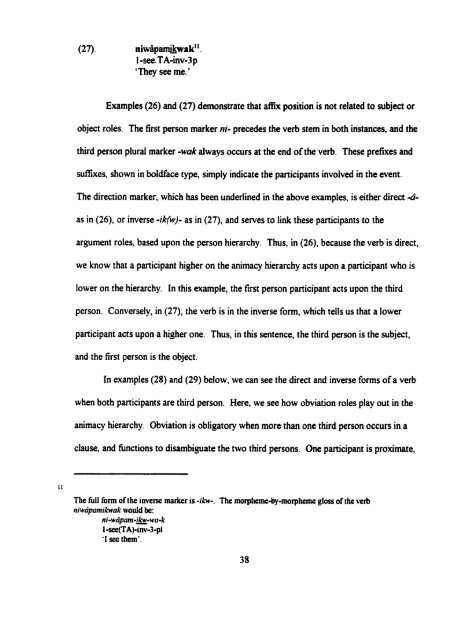Adverbial and Argument-Doubling Clauses in Cree - MSpace
Adverbial and Argument-Doubling Clauses in Cree - MSpace
Adverbial and Argument-Doubling Clauses in Cree - MSpace
You also want an ePaper? Increase the reach of your titles
YUMPU automatically turns print PDFs into web optimized ePapers that Google loves.
(27)- niwâpamhak1!<br />
1 -sec. TA-<strong>in</strong>v-3 p<br />
'They see me.'<br />
Examples (26) <strong>and</strong> (27) dem onstrate that a& p osition is not related t O subject or<br />
object roles. The first person marker ni- precedes the verb stem <strong>in</strong> both <strong>in</strong>stances, <strong>and</strong> the<br />
third person plural marker -wuk always occurs at the end of the verb. These prefixes <strong>and</strong><br />
suffixes, shown <strong>in</strong> boldface type, simply <strong>in</strong>dicate the participants <strong>in</strong>voived <strong>in</strong> the event.<br />
The direction marker, which has been underl<strong>in</strong>ed <strong>in</strong> the above examples, is either direct 4-<br />
as <strong>in</strong> (26), or <strong>in</strong>verse -ik(*-<br />
as <strong>in</strong> (27), <strong>and</strong> serves to l<strong>in</strong>k these participants to the<br />
argument roles. based upon the person hierarchy. Thus, <strong>in</strong> (26), because the verb is direct,<br />
we know that a participant higher on the animacy hierarchy aas upon a participant who is<br />
lower on the hierarchy. In this example, the first person participant acts upon the third<br />
person. Conversely, <strong>in</strong> (27), the verb is <strong>in</strong> the <strong>in</strong>verse form, which tells us that a lower<br />
participant acts upon a higher one. Thus, <strong>in</strong> this sentence, the third person is the subject,<br />
<strong>and</strong> the first person is the object.<br />
In examples (28) <strong>and</strong> (29) below, we can see the direct <strong>and</strong> <strong>in</strong>verse forms of a verb<br />
when both participants are third person. Here, we see how obviation roles play out <strong>in</strong> the<br />
animacy hierarchy. Obviation is obligatory when more than one third person occurs <strong>in</strong> a<br />
clause, <strong>and</strong> ti<strong>in</strong>ctions to disambiguate the two third persons. One participant is proximate,<br />
11<br />
The full form of the <strong>in</strong>verse marker is -ihw-. The morpheme-by-morpheme gloss of the ver&<br />
niwipamiAwak would be:<br />
ni-wdjmn-i&-wn-k<br />
1 -(TA)-<strong>in</strong>v-3-pl<br />
'1 see them'.








![an unusual bacterial isolate from in partial fulf]lment for the ... - MSpace](https://img.yumpu.com/21942008/1/190x245/an-unusual-bacterial-isolate-from-in-partial-fulflment-for-the-mspace.jpg?quality=85)




![in partial fulfil]ment of the - MSpace - University of Manitoba](https://img.yumpu.com/21941988/1/190x245/in-partial-fulfilment-of-the-mspace-university-of-manitoba.jpg?quality=85)


